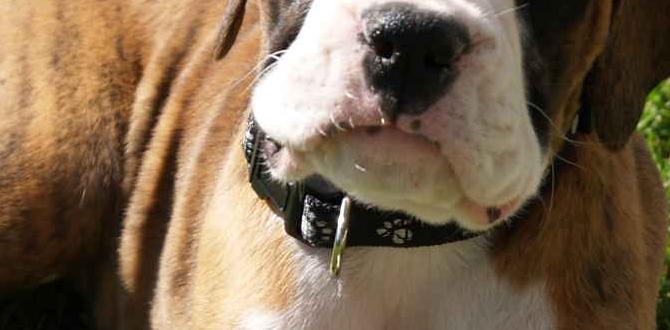Do you have a stubborn dog at home? Many dog owners face this challenge. It’s frustrating when your furry friend ignores commands or refuses to listen. You’re not alone in this! Did you know that stubbornness in dogs can often be a sign of boredom or lack of training? Understanding this can lead to better solutions for stubborn dogs.
Imagine a scenario: you call your dog for the fifth time, and they just stare at you. It can feel like you’re talking to a wall! But don’t worry, there are many effective solutions for stubborn dogs. These tips can turn your leash puller into a well-behaved companion.
In this article, we will explore creative and fun methods to help you deal with stubborn dogs. Let’s dive into the exciting world of dog training and discover how to make every walk enjoyable!
Effective Solutions For Stubborn Dogs: Training Tips And Techniques
Solutions for Stubborn Dogs
Dealing with stubborn dogs can be frustrating. Have you ever wondered why your furry friend ignores your commands? Understanding your dog’s behavior is key. Positive reinforcement works wonders; tasty treats can motivate them. Consistency is essential too; always use the same commands. Training can be fun! Try engaging activities like games that keep their attention. Remember, patience is vital. With the right approach, you can turn stubbornness into a willingness to listen!Understanding Stubborn Behavior in Dogs
Definition and characteristics of stubborn dogs. Common breeds prone to stubbornness.Dogs can be stubborn. This means they might not listen or follow commands right away. Some traits of stubborn dogs include:
- Difficulty in training
- Strong-willed nature
- Defiance to commands
Some breeds are known for this stubbornness. They often have their own ideas about what they want. Common stubborn breeds include:
- Bulldogs
- Shiba Inus
- Jack Russell Terriers
Understanding these traits can help you find solutions for stubborn dogs.
What causes stubborn behavior in dogs?
Stubborn behavior in dogs can come from their natural instincts, personality, and past experiences. Some dogs may become stubborn if they feel stressed or untrusted.
Identifying the Root Causes of Stubbornness
Environmental factors affecting behavior. Genetic and breedspecific traits.Dogs can be stubborn for many reasons. First, environment plays a big role. A loud or busy home can make dogs anxious. They might ignore commands due to distractions. Second, genetics and breed-specific traits matter too. Some breeds, like terriers, are naturally more willful. Other breeds may need more patience to train. Understanding these factors can help you find the right approach to deal with stubborn behaviors.
What environmental factors can affect dog behavior?
Noise, stress, and distractions in the home can lead to stubborn behavior in dogs.
Genetic and breed traits that contribute to stubbornness:
- Terriers are often independent.
- Hounds may follow their nose instead of commands.
- Working breeds are strong-willed and may need more guidance.
Positive Reinforcement Training Techniques
Importance of rewards in training. Effective methods to encourage good behavior.
- Terriers are often independent.
- Hounds may follow their nose instead of commands.
- Working breeds are strong-willed and may need more guidance.
Positive Reinforcement Training Techniques
Importance of rewards in training. Effective methods to encourage good behavior.Rewards are like magic for stubborn dogs! They help teach good behavior in a fun way. Imagine giving your pup a tasty treat every time they sit on command. It makes them feel like a superstar! Positive reinforcement can change your dog’s attitude and make training enjoyable.
Here are some great methods to encourage good behavior:
| Method | Description |
|---|---|
| Clicker Training | Use a click sound to mark good behavior, followed by a treat. |
| Treat Jar | Keep special treats for training; they’ll love it! |
| Praise | Don’t forget to give lots of belly rubs and happy words! |
Always remember, a happy dog learns better! With patience and rewards, you can turn your stubborn pup into a well-behaved companion. After all, who doesn’t like a little fun in learning?
Establishing a Consistent Routine
Benefits of a structured schedule. Tips for creating a daily routine for training.Having a set routine helps dogs feel safe and secure. A consistent schedule makes training easy and fun. It can reduce stress for both you and your furry friend. Here are some helpful tips:
- Choose a specific time for training each day.
- Use the same commands and words during sessions.
- Be patient when your dog learns something new.
- Mix fun activities with training to keep it enjoyable.
A structured routine builds trust and understanding. Remember, “Practice makes perfect!” Regular practice leads to success!
What are the benefits of a routine for my dog?
A routine helps your dog feel secure. It sets clear expectations and reduces anxiety. A happy dog is a well-behaved dog!
Addressing Behavioral Issues through Socialization
Importance of socialization for stubborn dogs. How to effectively socialize your dog.Socialization is key for stubborn dogs. It helps them feel comfortable around people and other pets. When a dog meets new friends, it learns how to behave. Good social skills make life happier for everyone. Here are ways to socialize your stubborn dog:
- Start young. Begin with puppies.
- Use safe places like parks.
- Invite friendly dogs over.
- Attend training classes.
- Reward positive behavior.
These steps help dogs gain confidence and reduce bad habits. Remember, socialization takes time and patience!
Why is socialization important for stubborn dogs?
Socialization helps stubborn dogs learn how to behave well with others. This makes them happier and less anxious. It also improves the bond between you and your dog.
How can I effectively socialize my dog?
- Set regular playdates with other dogs.
- Take your dog to different places.
- Practice new things, like car rides.
Utilizing Professional Training Services
Types of trainers and services available. How to choose the right trainer for your dog.Finding the right help for your stubborn dog can be a game changer. There are different types of trainers out there. Some focus on obedience, while others specialize in behavior issues. You may even find trainers who use fun methods like agility courses! Choosing the right one? Ask questions! Look for experience and a good fit for your pup’s personality. Remember, a happy dog makes for a happy owner, and well-trained dogs are often just a treat away from being superstars!
| Type of Trainer | Focus Area |
|---|---|
| Obedience Trainer | Basic commands |
| Behavior Specialist | Behavior issues |
| Agility Trainer | Fun and fitness |
Corrective Action for Common Stubborn Behaviors
Strategies for overcoming specific stubborn habits. Tips for managing aggression or disobedience.Stubborn dogs can test your patience. But don’t worry! There are fun ways to correct their tricky habits. For pulling on the leash, try using a harness that makes them feel like a superhero. Want to manage aggression? Use a calm voice and a treat to distract them. Remember, it’s key to stay consistent! Check out our handy tips in the table below:
| Behavior | Solution |
|---|---|
| Pulling on the leash | Use a harness and reward good walking! |
| Barking excessively | Teach a quiet command with tasty treats! |
| Aggression towards other dogs | Distract with a toy and practice calmness! |
Keep it fun! Don’t forget to celebrate small wins with praise. A happy pup is a well-behaved pup!
Incorporating Mental and Physical Stimulation
Activities to keep a stubborn dog engaged. Importance of exercise in behavior management.Keeping a stubborn dog happy takes more than love. They need both mental and physical stimulation. Bored dogs can act out. Fun activities can help them stay engaged. Consider these ideas:
- Play fetch in the yard.
- Take short walks with some playtime.
- Use puzzle toys to challenge their minds.
- Try agility training with simple obstacles.
Regular exercise helps make dogs calmer and better behaved. According to experts, active dogs are less likely to develop bad habits. So, let’s keep our furry friends busy!
What are some fun activities for dogs?
Fun activities include playing fetch, going for walks, and solving puzzles.
Real-Life Success Stories
Brief case studies of stubborn dogs transformed. Key takeaways from each success story.Many dogs can be stubborn, but inspiring transformations happen every day. Here are some real-life success stories showing how early training changes stubborn dogs into well-behaved pets:
- Max the Beagle: He ignored commands. With consistent training and patience, he learned to follow simple commands. Key takeaway: Consistency is crucial.
- Lola the Poodle: She refused to walk on a leash. After practicing short walks daily, she gained confidence. Key takeaway: Start small and celebrate progress.
- Buddy the Boxer: He jumped on guests. Training with positive rewards helped him sit calmly. Key takeaway: Positive reinforcement works wonders.
Conclusion
In summary, solving stubborn dog behavior takes patience and teamwork. Use positive reinforcement and fun training sessions to help your pup learn. Keep your expectations realistic and stay consistent. If needed, seek advice from a dog trainer. Explore more resources on dog training to continue your journey. Together, we can make training enjoyable for you and your furry friend!FAQs
What Are Effective Training Techniques For Addressing Stubborn Dog Behaviors?To help with stubborn dog behaviors, try using positive reinforcement. This means giving your dog treats or praise when they do what you want. Consistency is also important; always use the same command for the same action. Short, fun training sessions work best. Remember to be patient and keep practicing!
How Can Positive Reinforcement Be Used To Motivate A Stubborn Dog During Training?You can use treats or toys to reward your dog when it listens to you. When your dog does what you want, give them a small treat right away. This helps them learn that good behavior gets them something fun or tasty. You should also use lots of praise, like saying, “Good job!” This encourages your dog to keep trying.
What Role Does Consistency Play In Managing A Stubborn Dog’S Behavior?Consistency is very important when dealing with a stubborn dog. When you always use the same commands and rules, your dog learns better. If you let your dog get away with bad behavior sometimes, it gets confusing. By being the same every day, you help your dog understand what you want. This way, you both will be happier and have a better time together!
Are There Specific Breeds That Are More Prone To Stubbornness, And How Can Their Training Differ?Yes, some dog breeds are known to be more stubborn, like Bulldogs and Dachshunds. Their training can be different because they might not listen as quickly. We should use lots of treats and praise to encourage them. It’s also good to be patient and keep training fun. This way, they will learn better!
What Strategies Can Be Implemented To Keep A Stubborn Dog Engaged And Focused During Obedience Training Sessions?To keep a stubborn dog engaged in training, use fun games. You can try using treats as rewards when your dog follows a command. Always be patient and cheerful. Break training into short sessions so your dog doesn’t get tired. Finally, mix up the commands to keep things exciting!
Meet Elyse Colburn, the devoted canine companion and storyteller behind the enchanting world of “Tales, Tails, and Adventures Unleashed.” A passionate dog enthusiast with a heart full of paw prints, Elyse Colburn shares heartwarming tales and insightful adventures, celebrating the joy, loyalty, and endless antics that make every dog a true hero. Join Elyse Colburn on this tail-wagging journey, where every post is a love letter to our four-legged friends.







